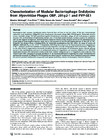Characterization of Modular Bacteriophage Endolysins from Myoviridae Phages OBP, 201 phi 2-1 and PVP-SE1
dc.contributor.author
Walmagh, Maarten
dc.contributor.author
Briers, Yves
dc.contributor.author
dos Santos, Silvio B.
dc.contributor.author
Azeredo, Joana
dc.contributor.author
Lavigne, Rob
dc.date.accessioned
2018-08-30T10:48:29Z
dc.date.available
2017-06-10T02:00:15Z
dc.date.available
2018-08-30T10:48:29Z
dc.date.issued
2012-05-15
dc.identifier.issn
1932-6203
dc.identifier.other
10.1371/journal.pone.0036991
en_US
dc.identifier.uri
http://hdl.handle.net/20.500.11850/51000
dc.identifier.doi
10.3929/ethz-b-000051000
dc.description.abstract
Peptidoglycan lytic enzymes (endolysins) induce bacterial host cell lysis in the late phase of the lytic bacteriophage replication cycle. Endolysins OBPgp279 (from Pseudomonas fluorescens phage OBP), PVP-SE1gp146 (Salmonella enterica serovar Enteritidis phage PVP-SE1) and 201φ2-1gp229 (Pseudomonas chlororaphis phage 201φ2-1) all possess a modular structure with an N-terminal cell wall binding domain and a C-terminal catalytic domain, a unique property for endolysins with a Gram-negative background. All three modular endolysins showed strong muralytic activity on the peptidoglycan of a broad range of Gram-negative bacteria, partly due to the presence of the cell wall binding domain. In the case of PVP-SE1gp146, this domain shows a binding affinity for Salmonella peptidoglycan that falls within the range of typical cell adhesion molecules (Kaff = 1.26×106 M−1). Remarkably, PVP-SE1gp146 turns out to be thermoresistant up to temperatures of 90°C, making it a potential candidate as antibacterial component in hurdle technology for food preservation. OBPgp279, on the other hand, is suggested to intrinsically destabilize the outer membrane of Pseudomonas species, thereby gaining access to their peptidoglycan and exerts an antibacterial activity of 1 logarithmic unit reduction. Addition of 0.5 mM EDTA significantly increases the antibacterial activity of the three modular endolysins up to 2–3 logarithmic units reduction. This research work offers perspectives towards elucidation of the structural differences explaining the unique biochemical and antibacterial properties of OBPgp279, PVP-SE1gp146 and 201φ2-1gp229. Furthermore, these endolysins extensively enlarge the pool of potential antibacterial compounds used against multi-drug resistant Gram-negative bacterial infections.
en_US
dc.format
application/pdf
en_US
dc.language.iso
en
en_US
dc.publisher
PLOS
dc.rights.uri
http://creativecommons.org/licenses/by/3.0/
dc.title
Characterization of Modular Bacteriophage Endolysins from Myoviridae Phages OBP, 201 phi 2-1 and PVP-SE1
en_US
dc.type
Journal Article
dc.rights.license
Creative Commons Attribution 3.0 Unported
ethz.journal.title
PLoS ONE
ethz.journal.volume
7
en_US
ethz.journal.issue
5
en_US
ethz.journal.abbreviated
PLoS ONE
ethz.pages.start
e36991
en_US
ethz.size
10 p.
en_US
ethz.version.deposit
publishedVersion
en_US
ethz.identifier.wos
ethz.publication.place
San Francisco, CA
ethz.publication.status
published
en_US
ethz.date.deposited
2017-06-10T02:00:33Z
ethz.source
ECIT
ethz.identifier.importid
imp59364f5f2d68f56465
ethz.ecitpid
pub:83228
ethz.eth
yes
en_US
ethz.availability
Open access
en_US
ethz.rosetta.installDate
2017-07-14T17:52:28Z
ethz.rosetta.lastUpdated
2024-02-02T05:51:20Z
ethz.rosetta.versionExported
true
ethz.COinS
ctx_ver=Z39.88-2004&rft_val_fmt=info:ofi/fmt:kev:mtx:journal&rft.atitle=Characterization%20of%20Modular%20Bacteriophage%20Endolysins%20from%20Myoviridae%20Phages%20OBP,%20201%20phi%202-1%20and%20PVP-SE1&rft.jtitle=PLoS%20ONE&rft.date=2012-05-15&rft.volume=7&rft.issue=5&rft.spage=e36991&rft.issn=1932-6203&rft.au=Walmagh,%20Maarten&Briers,%20Yves&dos%20Santos,%20Silvio%20B.&Azeredo,%20Joana&Lavigne,%20Rob&rft.genre=article&rft_id=info:doi/10.1371/journal.pone.0036991&
Files in this item
Publication type
-
Journal Article [128837]

